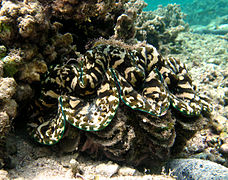
A cockle is an edible marine bivalve mollusc. Although many small edible bivalves are loosely called cockles, true cockles are species in the family Cardiidae.

Zooxanthellae is a colloquial term for single-celled dinoflagellates that are able to live in symbiosis with diverse marine invertebrates including demosponges, corals, jellyfish, and nudibranchs. Most known zooxanthellae are in the genus Symbiodinium, but some are known from the genus Amphidinium, and other taxa, as yet unidentified, may have similar endosymbiont affinities. The true Zooxanthella K.brandt is a mutualist of the radiolarian Collozoum inerme and systematically placed in Peridiniales. Another group of unicellular eukaryotes that partake in similar endosymbiotic relationships in both marine and freshwater habitats are green algae zoochlorellae.

Tridacna gigas, the giant clam, is the best-known species of the giant clam genus Tridacna. Giant clams are the largest living bivalve mollusks. Several other species of "giant clam" in the genus Tridacna are often misidentified as Tridacna gigas.

Tridacna is a genus of large saltwater clams, marine bivalve molluscs in the subfamily Tridacninae, the giant clams. Many Tridacna species are threatened. They have heavy shells, fluted with 4 to 6 folds. The mantle is often brightly coloured. They inhabit shallow waters of coral reefs in warm seas of the Indo-Pacific region. These clams are popular in marine aquaria, and in some areas, such as the Philippines, members of the genus are farmed for the marine aquarium trade. They live in symbiosis with photosynthetic algae (zooxanthellae). Some species are eaten by humans.

The maxima clam, also known as the small giant clam, is a species of bivalve mollusc found throughout the Indo-Pacific region.

Hippopus hippopus, also known as the Horse Hoof clam and Strawberry clam, is a species of giant clam in the Subfamily Tridacninae and the genus Hippopus. Hippopus is a delicacy in many Southeast Asian countries due to its high quality meat.

Tridacna crocea, the boring clam, crocus clam, crocea clam or saffron-coloured clam, is a species of bivalve in the family Cardiidae. It is native to the Indo-Pacific region. It is occasionally found in the aquarium trade where it is often simply referred to as crocea.

Tridacna derasa, the southern giant clam or smooth giant clam, is a species of extremely large marine clam in the family Cardiidae.

Rosewater’s giant clam is a species of marine bivalve in the family Cardiidae. For a while, the species was thought to be extinct, until it was redicovered in 2020. It was thought to be a new species, Tridacna lorenzi, but further research has shown that it is actually Rosewater’s giant clam.

Tridacnidae, common name the giant clams, is a taxonomic subfamily of very large saltwater clams, marine bivalve molluscs in the family Cardiidae, the cockles.

Corculum is a genus of small saltwater clams, marine bivalve molluscs in the family Cardiidae, the cockles. They maintain Symbiodinium dinoflagellates as symbionts.

Corculum cardissa, the heart cockle, is a species of marine bivalve mollusc in the family Cardiidae. It is found in the Indo-Pacific region. It has a symbiotic relationship with dinoflagellates (zooxanthellae), which live within its tissues.

Fragum unedo is a species of cockle, a marine bivalve mollusc in the family Cardiidae, commonly known as the Pacific strawberry cockle. It is found in tropical seas in the Indo-Pacific region and the empty shells are prized for use in decorative crafts.

Bartholomea annulata is a species of sea anemone in the family Aiptasiidae, commonly known as the ringed anemone or corkscrew anemone. It is one of the most common anemones found on reefs in the Caribbean Sea.

Fragum erugatum is a small species of cockle, a marine bivalve mollusc in the family Cardiidae. It is found in the shallow seas off the coast of Western Australia. It is commonly known as the Hamelin cockle, cardiid cockle or heart cockle.

Cynarina lacrymalis is a species of stony coral in the family Lobophylliidae. It is variously known as the flat cup coral, solitary cup coral, button coral, doughnut coral, or cat's eye coral. It is found in the western Indo-Pacific Ocean and is sometimes kept in reef aquaria.

Tridacna noae, also known as Noah’s giant clam or the Teardrop giant clam, is a species of giant clam. Up until recently, T. noae was confused with the small giant clam Tridacna maxima, but is now known to be its own independent species. It has a broad distribution in the Indo-Pacific.

Pseudofulvia is a genus of saltwater clams, marine bivalve mollusks in the subfamily Laevicardiinae of the family Cardiidae, the cockles.

Tridacna squamosina is a species of the Tridacna genus, the giant clams. These animals are bivalve mollusks belonging to the family Cardiidae identified by Sturany 1899.

























